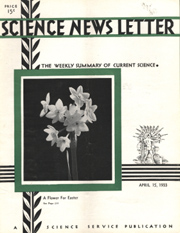From the April 15, 1933, issue

NARCISSI MERIT RECOGNITION AS PROPER EASTER FLOWERS
Easter has always been a festival of flowers. Indeed, one of the reasons why the early missionary church found it comparatively easy to get its converts to adopt this holy day was because most of them already had a holiday at the same season–a celebration of the returning sun, when they garnished houses and temples with fresh flowers.
There is, however, a curious inappropriateness in the almost universal use nowadays of the long-throated lily species that has by common consent come to be known as the Easter lily. In the first place, Easter is not its natural time of blooming: it has to be forced to get it into flower at this time of year. Moreover, it is not native to the lands of the Easter tradition but comes from Japan; it was quite unknown to Western horticulture until after the commercial opening of that still pagan land.
Much more appropriate, it would seem, would be the recognition of the narcissi to a leading place in the Easter floral display. The various species of narcissus flower early, even in our northern lands, and many of them are ready for Easter without forcing. The best known of them, like the paper-whites and the poets narcissus, are native to the Mediterranean lands, the fountainhead and early home of the Christian tradition.
The photograph of the paper-white narcissus on the cover is the work of Cornelia Clarke.
NEW FUNCTIONS DISCOVERED FOR SECRETIONS OF ADRENAL GLANDS
Important new functions of the vital adrenal glands, concerned with vitamin utilization and milk production, were reported by Drs. Frank A. Hartman, J.E. Lockwood, and K.A. Brownell of the University of Buffalo to the Federation of American Societies for Experimental Biology.
Members of the Federation have previously heard the Buffalo investigators describe the life-saving cortin, which they extracted from the cortex of these two small glands that lie just above the kidneys. Cortin has saved the lives of sufferers from Addisons disease, an ailment in which the adrenal glands are diseased and fail to produce enough cortin themselves for the bodys needs. Animals deprived of their adrenal glands quickly die, but their lives may be prolonged indefinitely by administration of cortin.
This week the Buffalo investigators reported experiments suggesting that adrenal cortical extract, possibly cortin itself, helps the body utilize vitamins C and B1. Likewise, they have separated from cortical extract a substance that is necessary for the production of milk. They call this new hormone cortilactin.
RESEARCH INDICATES VITAMIN C MAY CONTAIN CURE FOR GOITER
A further means of controlling the still baffling disease goiter may be found in vitamin C, it appears from the latest work of a pioneer in goiter research, Dr. David Marine of the Montefiore Hospital in New York.
Working with Drs. E.J. Baumann, B. Webster, and A. Cipra, Dr. Marine produced goiters in rabbits by feeding them cabbage. The extract was made by the same method Szent-Györgi used in preparing hexuronic acid from certain plant tissues and from adrenal gland cortex. It is thought to be vitamin C, just as hexuronic acid itself is now believed to be vitamin C.







